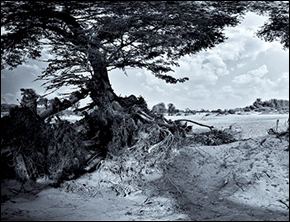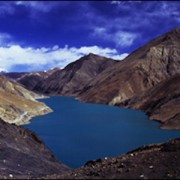Drought in the Mekong Basin Hampers Southeast Asia Economy
A short monsoon and low rainfall have cut the region’s economic lifeblood to a trickle

One of the worst droughts in Southeast Asia in decades has lowered water levels in the Mekong River, cutting people off from the source of their livelihood and hampering the regional economy, the Bangkok Post reports.
“Severe drought will have an impact on agriculture, food security, access to clean water and river transport and will affect the economic development of people already facing serious poverty. The northern provinces are amongst the poorest areas for both Lao PDR and Thailand,” according to a press release by the Mekong River Commission (MRC), a forum for joint development of the river basin.
With some areas of the river left only 35 centimeters deep, Thai officials halted barge traffic and ferries.
While the Mekong is a vital regional transport link, trade activity is now being shifted to highways. Thailand’s Chiang Rai customs office said truck traffic on the road to Yunnan has recently increased from 50 trailers per month to 50 per day, the Bangkok Post reports.
Agriculture and tourism are other industries relying on the river. Some tour operators have stopped running ferries around the tourist area of Luang Prabang, according to the MRC release.
Thailand’s Irrigation Department has started emergency conservation measures, the Pattaya Daily News reports. The department is using mobile pumps for water distribution and emphasizing the need to conserve water. Rice farmers are being urged to plant crops that require less water and to refrain from planting a second rice crop.
The people most affected are subsistence farmers, according to a lecturer at Ubon Ratchathani University.
“When farmers cannot rely on water from the Mekong, many of them will have to seek new jobs and change their way of life,” Kanokwan Manorom told the Pattaya Daily News.
The drought was caused by an early end to the monsoon season coupled with lower-than-average rainfalls since September, according to a preliminary assessment by the MRC.
Although Chinese dams have been popular scapegoats for problems of water quantity on the Mekong, the MRC’s assessment focused on climatic factors.
Meanwhile, the Thai government is trying to raise concerns about more coordinated river management with China, which is not a part of the MRC.
“We can see the level of the water is getting lower,” said Thai premier Abhisit Vejjajiva, AFP reports. “We will ask the foreign ministry to talk with a representative from China in terms of co-operation and in terms of management systems in the region.”
Water levels are expected to continue to drop until late April, according to the MRC report.
More on the Mekong River from Circle of Blue: Visioning Flowing Waters, From Laos to Cambodia
Source: Bangkok Post, Pattaya Daily News, AFP
Brett writes about agriculture, energy, infrastructure, and the politics and economics of water in the United States. He also writes the Federal Water Tap, Circle of Blue’s weekly digest of U.S. government water news. He is the winner of two Society of Environmental Journalists reporting awards, one of the top honors in American environmental journalism: first place for explanatory reporting for a series on septic system pollution in the United States(2016) and third place for beat reporting in a small market (2014). He received the Sierra Club’s Distinguished Service Award in 2018. Brett lives in Seattle, where he hikes the mountains and bakes pies. Contact Brett Walton






Trackbacks & Pingbacks
[…] in memory. You can read about it at the The Voice of America website: and in another article, Drought in the Mekong Basin. I talked to my friend Nai last night, and the drought is affecting him and his family. One the one […]
[…] in bulk), and the crops are hurting. The Weather Underground site also reports that March was the hottest or 2nd hottest month on record globally (depending on which agency–NOAA or NASA–reported it). To top it all off, Nai’s […]
Leave a Reply
Want to join the discussion?Feel free to contribute!